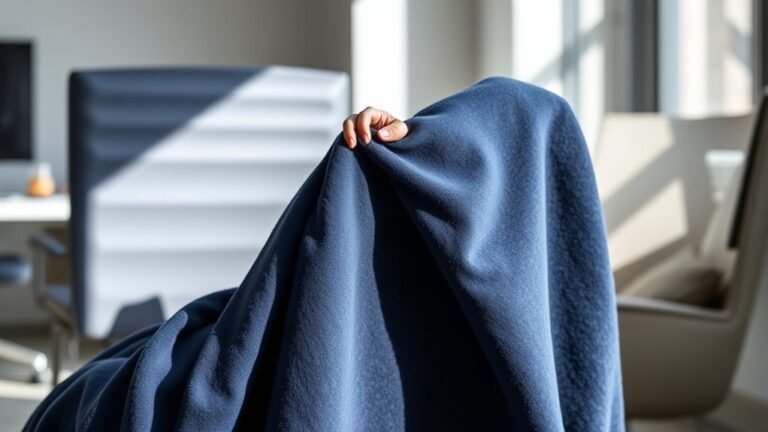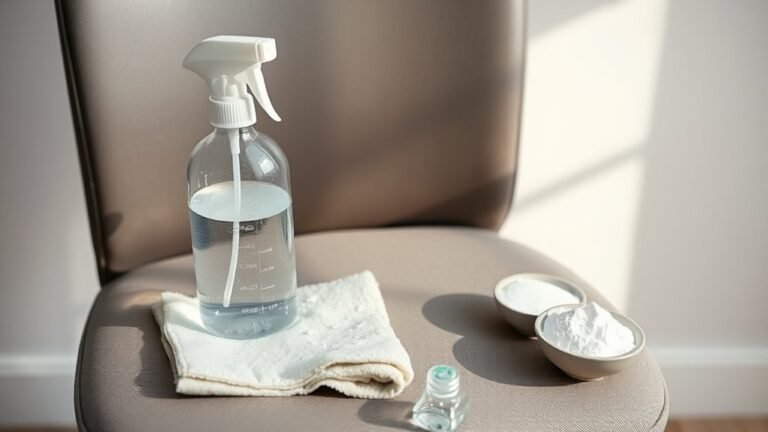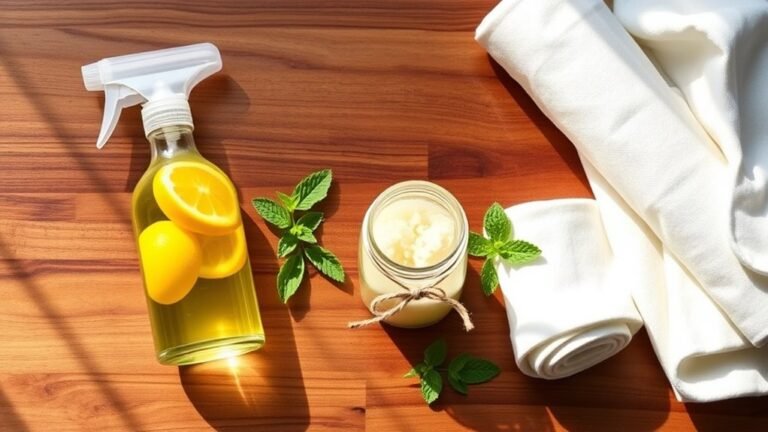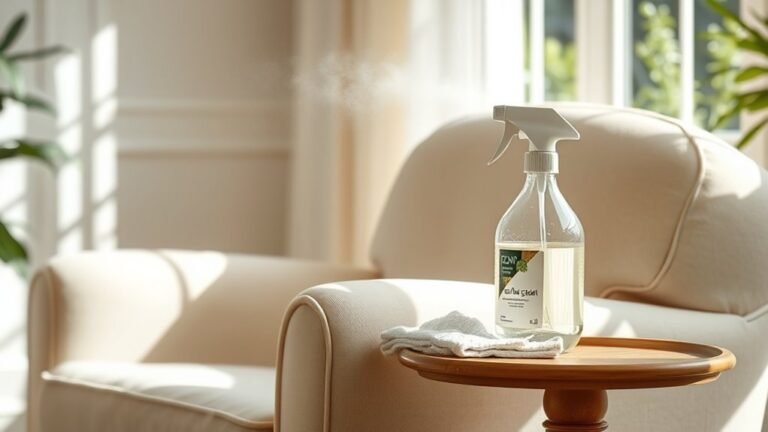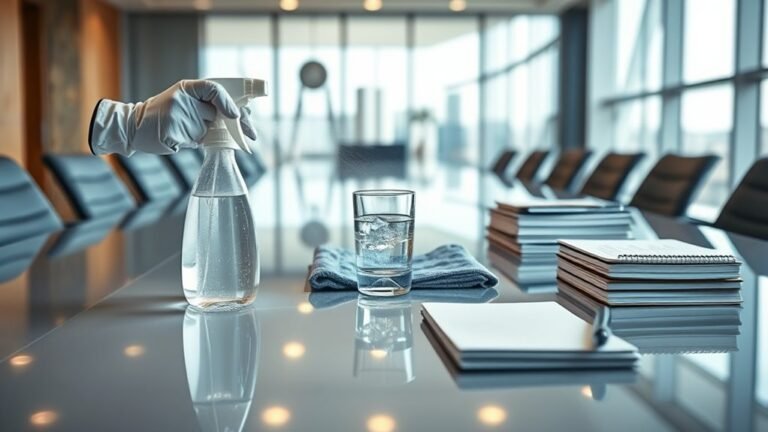How to Clean Bathroom in Office Spaces
To clean office bathrooms effectively, first set a schedule based on usage to stay consistent without overdoing it. Gather essential supplies like gloves, disinfectants, brushes, and microfiber cloths, and handle chemicals safely. Focus on thoroughly disinfecting toilets, sinks, and countertops while preventing cross-contamination. Don’t forget floors—sweep, mop, and disinfect properly. Finally, control odors with ventilation and air fresheners. If you want to keep your workspace hygienic and inviting, there’s plenty more to explore on this topic.
Assessing Cleaning Frequency and Scheduling

Before you set a cleaning schedule for your office bathroom, consider how often it’s used and the number of employees sharing the space. This frequency assessment is essential because it helps you tailor cleaning schedules that keep the space fresh without overburdening your routine. If your bathroom sees heavy traffic, daily cleanings might be necessary, while a smaller team might only require a few times per week. Think about peak hours and any special events that might increase usage. By understanding these patterns, you gain the freedom to create an efficient, no-nonsense cleaning schedule that fits your office’s unique needs. This approach not only maintains hygiene but also respects your time and resources, giving you control without unnecessary hassle.
Gathering Essential Cleaning Supplies
Once you’ve figured out how often your office bathroom needs cleaning, the next step is to gather the right supplies. Start by creating a cleaning checklist to guarantee you don’t miss any essentials. You’ll need gloves, disinfectant sprays, toilet bowl cleaner, scrub brushes, microfiber cloths, paper towels, and a mop. Having everything organized saves time and lets you clean efficiently, giving you more freedom during your day.
Consider your supply storage carefully—choose a spot that’s easy to access but keeps chemicals safely out of reach. A well-organized storage area helps you maintain your checklist and restock supplies promptly. By preparing thoughtfully, you’ll make bathroom cleaning smoother and less of a chore, freeing you up to focus on more important tasks.
Proper Techniques for Toilet and Urinal Cleaning

When cleaning toilets and urinals, you need to focus on effective disinfection to eliminate germs thoroughly. Make certain you use cleaning products safely by following the instructions and wearing protective gear. This approach guarantees a hygienic restroom environment without risking your health.
Effective Disinfection Methods
Although cleaning toilets and urinals might seem straightforward, using effective disinfection methods is essential to eliminate germs and maintain a hygienic environment. You’ll want to choose the right disinfectant types, such as those with bleach or quaternary ammonium compounds, because they target a broad range of bacteria and viruses. Apply disinfectants thoroughly, ensuring every surface, including handles and rims, is covered. Let the product sit for the recommended contact time to work effectively. When it comes to cleaning techniques, use separate cloths or disposable wipes to avoid cross-contamination. Scrub surfaces with a toilet brush or sponge to remove buildup before disinfecting. By following these steps, you’re not just cleaning—you’re creating a safer, fresher space where everyone feels comfortable and free from harmful germs.
Safe Cleaning Product Use
Two key steps will help you use cleaning products safely and effectively on toilets and urinals. First, always prioritize chemical safety by reading labels carefully and wearing gloves to protect your skin. Avoid mixing chemicals, as this can create harmful fumes. Second, consider eco friendly options that clean well without harsh toxins, giving you freedom from worrying about environmental impact or health risks. When applying cleaners, focus on the bowl’s underside and rim, letting the product sit a few minutes before scrubbing with a dedicated brush. Flush to rinse thoroughly. For urinals, spray or pour cleaner on all surfaces, paying special attention to drain areas, then scrub and rinse. By following these steps, you’ll maintain hygiene while ensuring a safe, sustainable cleaning routine.
Effective Methods for Sink and Countertop Sanitization
Since sinks and countertops are high-touch areas in office bathrooms, you’ll want to focus on thorough cleaning and sanitization to prevent the spread of germs. Start with sink sanitization techniques by scrubbing the basin with a disinfectant cleaner, paying attention to faucet handles and drain edges. Use a soft brush or cloth to avoid scratching surfaces. For countertop cleaning methods, wipe down the area with a multi-surface cleaner, then follow up with a sanitizer spray to kill lingering bacteria. Always let surfaces air dry for maximum effectiveness. Remember, consistency is key—sanitize these spots daily or after heavy use to maintain a fresh, hygienic environment. By mastering these simple steps, you’ll keep your office bathroom safe and inviting without sacrificing your freedom to choose efficient practices.
Maintaining Mirrors and Glass Surfaces

Keeping mirrors and glass surfaces spotless in office bathrooms is essential for a polished look and a hygienic environment. For effective mirror maintenance, start by wiping down surfaces with a microfiber cloth to remove dust and grime without scratching. Use a streak-free glass cleaner or a vinegar-water solution to tackle smudges and water spots. When doing glass polishing, gentle circular motions with a soft cloth work best to restore shine without damaging the surface. Avoid abrasive materials that can leave scratches or dull the finish. Regular upkeep not only keeps the bathroom inviting but also extends the life of your mirrors and glass fixtures. By following these simple steps, you’ll guarantee a clean, fresh space that reflects well on your office’s professionalism and respect for freedom in cleanliness.
Floor Cleaning and Disinfection Strategies
When cleaning bathroom floors in office spaces, you’ll want to use effective methods that remove dirt and germs thoroughly. Choosing the right disinfectant is key to ensuring the area stays sanitary without damaging surfaces. Always keep safety in mind by wearing gloves and ensuring proper ventilation during the cleaning process.
Effective Floor Cleaning Methods
Although floor cleaning might seem straightforward, using the right methods and disinfectants is essential to maintain hygiene in office bathrooms. You’ll want to tailor your mopping techniques to the specific floor types you’re dealing with—whether it’s tile, vinyl, or concrete. For instance, a damp mop works well on tiles, while a slightly wet mop is better for vinyl to prevent water damage. Always start by sweeping or vacuuming to remove loose dirt and debris. Then, use a mop with a suitable cleaning solution, ensuring you wring it out well to avoid excess moisture. Changing mop water frequently keeps you from spreading germs around. By mastering these techniques, you’ll keep floors spotless and safe, creating a fresher, more inviting bathroom space without feeling confined by rigid routines.
Disinfectant Selection Tips
Why does choosing the right disinfectant matter for office bathroom floors? Because it directly impacts disinfectant effectiveness and protects your flooring material. You want a disinfectant that not only kills germs efficiently but also works well with the specific surface you’re cleaning. Using the wrong product might damage floors or leave residues, limiting your freedom to maintain a hygienic space without hassle.
When selecting a disinfectant, check its label for approved pathogens and recommended surfaces. Opt for one designed for high-traffic areas, ensuring it handles frequent use without losing potency. Also, consider eco-friendly options that balance effectiveness with environmental care. By focusing on surface compatibility and proven disinfectant effectiveness, you’ll confidently keep office bathroom floors clean, safe, and welcoming for everyone.
Safety Precautions During Cleaning
Since office bathroom floors see constant traffic, you’ll need to take specific safety precautions to protect yourself and others during cleaning. First, always wear personal protective equipment like gloves and slip-resistant shoes to avoid contact with germs and prevent slips. Next, practice safe chemical handling by reading labels carefully and mixing only recommended products to avoid harmful reactions. Use warning signs to alert others that the floor is wet—this keeps everyone safe and respects their freedom to move without risk. Ventilate the space well to minimize inhaling fumes, and never rush the process; thoroughness protects you and your coworkers. By following these straightforward steps, you maintain a clean, safe environment without compromising your freedom or well-being.
Implementing Air Freshening and Odor Control Measures
When you want to maintain a fresh and inviting bathroom in an office space, implementing effective air freshening and odor control measures is crucial. You have the freedom to choose the best scent options that suit your environment while enhancing air quality. Here’s how you can do it:
- Install automatic air fresheners that release subtle scents regularly.
- Use activated charcoal or baking soda to absorb odors naturally.
- Ascertain proper ventilation by keeping exhaust fans running efficiently.
- Place discreet essential oil diffusers to offer a pleasant, customizable aroma.
Frequently Asked Questions
How Do I Handle Hazardous Waste in Office Bathrooms?
When dealing with hazardous waste in office bathrooms, you’ve got to follow proper waste disposal guidelines to keep things safe and free. Don’t just toss hazardous materials in regular trash—use designated containers labeled for hazardous waste. Make sure you’re familiar with local regulations and have trained staff handle collection and disposal. This way, you’re protecting everyone’s health and maintaining a clean, hazard-free office environment without unnecessary restrictions.
What Are the Best Eco-Friendly Cleaning Products for Office Bathrooms?
You want cleaners that protect your health, preserve the planet, and perform well. Natural cleaners like vinegar, baking soda, and lemon juice are green alternatives that tackle grime without harsh chemicals. You can also find eco-friendly sprays made from plant-based ingredients, free from toxins and synthetic fragrances. Choosing these options lets you maintain a fresh, clean space while embracing freedom from pollutants and supporting a healthier environment for everyone.
How Can I Encourage Employees to Keep Bathrooms Clean?
You can boost employee engagement by making bathroom cleanliness a shared goal, encouraging everyone to take pride in their space. Try introducing cleanliness incentives like small rewards or recognition for teams that keep the bathroom tidy. Keep it light and voluntary—people appreciate freedom, so avoid strict rules. When employees feel involved and appreciated, they’re more likely to pitch in and maintain a clean, comfortable bathroom environment naturally.
What Is the Protocol for Cleaning After a Biohazard Spill?
You might think biohazard containment is too complicated, but it’s essential for everyone’s safety. When cleaning after a biohazard spill, you’ve got to follow strict safety procedures: wear protective gear, isolate the area, and use EPA-approved disinfectants. Don’t just wing it—you need to handle waste properly and dispose of it according to regulations. This protocol keeps you safe and maintains a healthy environment, giving you the freedom to work without worry.
How Often Should Bathroom Ventilation Systems Be Cleaned?
You should prioritize ventilation maintenance by cleaning bathroom ventilation systems at least every 3 to 6 months. This routine helps keep air quality fresh and minimizes odors or moisture buildup. If your office bathroom sees heavy use or you notice poor airflow, consider cleaning more frequently. Staying on top of this guarantees a healthier environment and gives you the freedom to breathe easy without worrying about stale, contaminated air lingering around.


